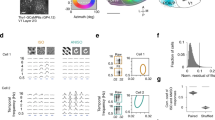Summary
The spatial frequency tuning curves of neurones of area 18 depend upon the velocity of the visual stimulus. The higher the velocity the lower the spatial frequencies to which the cell is tuned. Since in area 17 the size of the cell receptive field is inversely related with the optimal spatial frequency to which the cell responds, we have investigated whether the shift of the optimal spatial frequency with the velocity corresponds to a “change” in the receptive field size. We recorded extracellularly from neurones in area 18; for each cell we selected two gratings, one of high spatial frequency drifting at low velocity and another of low spatial frequency drifting at high velocity to which the cell gave comparable responses. The results show that the masking of the cells receptive field which abolishes the response to the high frequency low velocity grating does not prevent the cell from responding to the low frequency high velocity grating. We conclude that the size of the receptive field of neurones in area 18 depends upon the characteristics (spatial frequency and velocity) of the visual stimulus.
Similar content being viewed by others
References
Abramson BP, Chalupa LM (1985) The laminar distribution of cortical connections with the tecto- and cortico-recipient zones in the cat's lateral posterior nucleus. Neuroscience 15: 81–95
Andrews BW, Pollen DA (1979) Relationship between spatial frequency selectivity and receptive field profile of simple cells. J Physiol 287: 163–176
Berardi N, Bisti S, Cattaneo A, Fiorentini A, Maffei L (1982) Correlation between the preferred orientation and spatial frequency of neurones in visual areas 17 and 18 of the cat. J Physiol 323: 603–618
Bisti S, Carmignoto G, Galli L, Maffei L (1985) Spatial-frequency characteristics of neurones of area 18 in the cat: dependence on the velocity of the visual stimulus. J Physiol 359: 259–268
Derrington AM, Fuchs AF (1979) Spatial and temporal properties of X and Y cells in the cat lateral geniculate nucleus. J Physiol 293: 347–364
Dreher B, Cottee L (1975) Visual receptive field properties of cells in area 18 of the cat's cerebral cortex before and after acute lesions of area 17. J Neurophysiol 38: 735–750
Enroth-Cugell C, Robson JG (1966) The contrast sensitivity of retinal ganglion cells of the cat. J Physiol 187: 517–552
Ferster D (1986) Convergence of X- and Y-mediated excitation and inhibition in cat visual cortex. Soc Neurosci Abstr 12: 128
Freund TF, Martin KAC, Whitteridge D (1985a) Innervation of cat visual areas 17 and 18 by physiologically identified X- and Y-type thalamic afferents. I. Arborization patterns and quantitative distribution of postsynaptic elements. J Comp Neurol 242: 263–274
Freund TF, Martin KAC, Somogyi P, Whitteridge D (1985b) Innervation of cat visual areas 17 and 18 by physiologically identified X- and Y-type thalamic afferents. II. Identification of postsynaptic targets by GABA immunocytochemistry and Golgi impregnation. J Comp Neurol 242: 275–291
Hess R, Wolters W (1979) Responses of single cells in cat's lateral geniculate nucleus and area 17 to the velocity of moving visual stimuli. Exp Brain Res 34: 273–286
Hochstein S, Shapley RM (1976) Quantitative analysis of retinal ganglion cell classifications. J Physiol 262: 237–264
Hubel DH, Wiesel TN (1965) Receptive fields and functional architecture in two nonstriate visual areas (18 and 19) of the cat. J Neurophysiol 28: 229–298
Humphrey AL, Sur M, Uhlrich DJ, Sherman SM (1985) Termination patterns of X- and Y-cell axons in the visual cortex of the cat: projections to area 18, to the 17/18 border region, and to both areas 17 and 18. J Comp Neurol 233: 190–212
Kawamura K (1973) Cortical fiber connections of the cat cerebrum. III. The occipital region. Brain Res 51: 41–60
Lehmkuhle S, Kratz KE, Mangel SC, Sherman SM (1980) Spatial and temporal sensitivity of X- and Y-cells in dorsal lateral geniculate nucleus of the cat. J Neurophysiol 43: 520–541
Linsenmeier RA, Frishman LJ, Jakiela HG, Enroth-Cugell C (1982) Receptive field properties of X- and Y-cells in the cat retina derived from contrast sensitivity measurements. Vision Res 22: 1173–1183
Maffei L, Fiorentini A (1976) The unresponsive regions of visual cortical receptive fields. Vision Res 16: 1131–1140
Maffei L, Fiorentini A (1977) Spatial frequency rows in the striate visual cortex. Vision Res 17: 257–264
Maffei L, Morrone MC, Pirchio M, Sandini G (1979) Responses of visual cortical cells to periodic and non-periodic stimuli. J Physiol 296: 27–47
Movshon JA, Thompson ID, Tolhurst DJ (1978) Spatial and temporal contrast sensitivity of neurones in area 17 and 18 of the cat's visual cortex. J Physiol 283: 101–120
Orban GA, Callens M (1977) Receptive field types of area 18 neurones in the cat. Exp Brain Res 30: 107–123
Riva Sanseverino E, Galletti C, Maioli MG (1973) Responses to moving stimuli of single cells in the cat visual areas 17 and 18. Brain Res 55: 451–454
Riva Sanseverino E, Galletti C, Maioli MG (1974) Neurons with simple organization of the receptive field in the cat visual area 18. Arch Sci Biol 58: 1–8
Tretter F, Cynader M, Singer W (1975) Cat parastriate cortex: a primary or secondary visual area? J Neurophysiol 38: 1099–1113
Tolhurst DJ, Movshon JA (1975) Spatial and temporal contrast sensitivity of striate cortical neurones. Nature 257: 674–675
Wilson ME (1968) Cortico-cortical connections of the cat visual areas. J Anat 102: 357–386
Author information
Authors and Affiliations
Rights and permissions
About this article
Cite this article
Galli, L., Chalupa, L., Maffei, L. et al. The organization of receptive fields in area 18 neurones of the cat varies with the spatio-temporal characteristics of the visual stimulus. Exp Brain Res 71, 1–7 (1988). https://doi.org/10.1007/BF00247517
Received:
Revised:
Accepted:
Issue Date:
DOI: https://doi.org/10.1007/BF00247517



